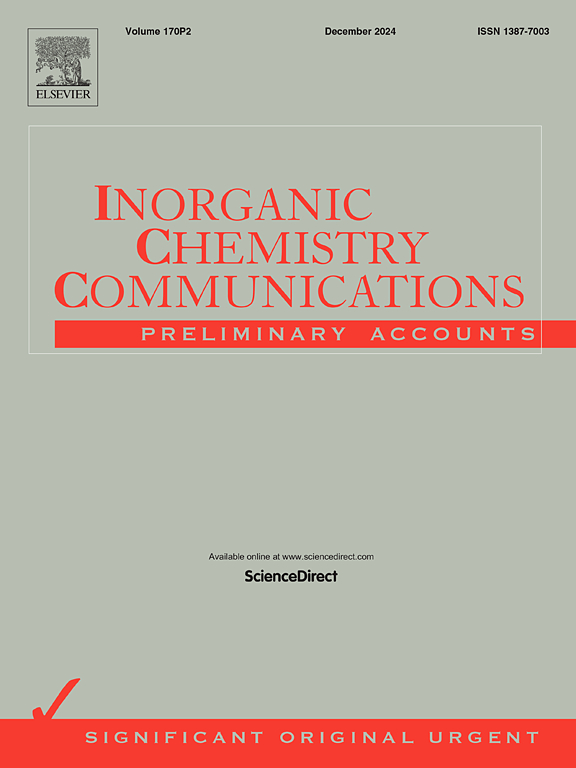RSM-CCD优化了生态友好型磁性活性炭薄膜吸附去除对硝基苯酚的性能
IF 4.4
3区 化学
Q1 CHEMISTRY, INORGANIC & NUCLEAR
引用次数: 0
摘要
对硝基苯酚(PNP)是一种对人类健康和生态系统构成重大风险的有害污染物。本研究通过用Fe0/Fe3O4纳米颗粒修饰活性炭薄膜(ACTF),开发了一种低成本的磁性吸附剂——磁性活性炭薄膜(MACTF)纳米复合材料,用于高效去除PNP。以不同比例的Fe0/Fe3O4合成了3种纳米复合材料(MACTF-1、MACTF-2和MACTF-3)。通过XRD、TEM、FTIR、Raman、BET、BJH和TGA等表征手段证实了纳米复合材料的成功合成。MACTF-1表现出最高的BET表面积(346 m2/g)和总孔隙体积,使其成为最有效的吸附剂。在响应面法(RSM)和中心复合设计(CCD)优化条件下(pH: 4.5, PNP浓度:69.5 mg), PNP去除率最高(94%)。L−1,接触时间117.9 min)。Freundlich等温线(R2 = 0.98, x2 = 0.67)和拟二级动力学(R2 = 0.99, x2 = 0.09)最适合描述吸附过程。热力学研究表明,吸附为放热吸附(ΔH˚<;0)和自发(ΔG˚<;在自然界中;重复使用测试表明,该吸附剂在连续5次循环后仍保持约80%的去除效率,突出了其实际应用潜力。研究表明,MACTF-1是一种高效、可重复使用、易于分离的水环境中PNP去除吸附剂。本文章由计算机程序翻译,如有差异,请以英文原文为准。

RSM-CCD optimized adsorptive removal of p-Nitrophenol using Eco-Friendly magnetic activated carbon thin Film
p-nitrophenol (PNP) is a hazardous pollutant that poses significant risks to human health and ecosystems. This study developed a low-cost magnetic adsorbent, magnetically activated carbon thin film (MACTF) nanocomposite by modifying activated carbon thin film (ACTF) with Fe0/Fe3O4 nanoparticles for efficient PNP removal. Three nanocomposites (MACTF-1, MACTF-2, and MACTF-3) were synthesized with varying proportions of Fe0/Fe3O4. Characterization using XRD, TEM, FTIR, Raman, BET, BJH, and TGA confirmed the successful synthesis of the nanocomposites. MACTF-1 exhibited the highest BET surface area (346 m2/g) and total pore volume, making it the most effective adsorbent. The highest PNP removal rate (94 %) was attained under optimized parameters identified through the Response Surface Methodology (RSM) utilizing the Central Composite Design (CCD) method (pH: 4.5, PNP concentration: 69.5 mg.L−1, and contact time: 117.9 min). The adsorption process was best described by the Freundlich isotherm (R2 = 0.98, X 2 = 0.67) and fitted a pseudo-second-order kinetics (R2 = 0.99, X 2 = 0.09). Thermodynamic studies revealed that the adsorption was exothermic (ΔH˚ < 0) and spontaneous (ΔG˚ < 0) in nature. Reusability tests demonstrated that the adsorbent retained approximately 80 % removal efficiency after five consecutive cycles, highlighting its potential for practical applications. The study concludes that MACTF-1 is a highly effective, reusable, and easily separable adsorbent for PNP removal from aqueous environments.
求助全文
通过发布文献求助,成功后即可免费获取论文全文。
去求助
来源期刊

Inorganic Chemistry Communications
化学-无机化学与核化学
CiteScore
5.50
自引率
7.90%
发文量
1013
审稿时长
53 days
期刊介绍:
Launched in January 1998, Inorganic Chemistry Communications is an international journal dedicated to the rapid publication of short communications in the major areas of inorganic, organometallic and supramolecular chemistry. Topics include synthetic and reaction chemistry, kinetics and mechanisms of reactions, bioinorganic chemistry, photochemistry and the use of metal and organometallic compounds in stoichiometric and catalytic synthesis or organic compounds.
 求助内容:
求助内容: 应助结果提醒方式:
应助结果提醒方式:


